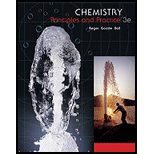
Interpretation:
The instantaneous rate for the change of other species has to be calculated and also the instantaneous
Answer to Problem 13.31QE
Instantaneous rate of appearance of water is
Explanation of Solution
The reaction that is given in the problem statement is shown below;
From the above equation, it is found that the stoichiometric relationship between
The instantaneous rate of formation of
Therefore, the appearance rate of water will be
The instantaneous rate of disappearance of
Therefore, the instantaneous disappearance rate of
The instantaneous rate of disappearance of
Therefore, the instantaneous disappearance rate of
The instantaneous rate of disappearance of
Therefore, the instantaneous disappearance rate of
Rate of the reaction can be found out by dividing the rate of appearance or disappearance of any species involved in the reaction by its coefficient. Therefore, the rate of the reaction can be calculated using the disappearance of hydroxide as shown below;
Therefore, the rate of the reaction is
Want to see more full solutions like this?
Chapter 13 Solutions
Chemistry
- Nitrosyl bromide, NOBr, is formed from NO and Br2: 2 NO(g) + Br2(g) 2 NOBr(g) Experiments show that this reaction is second-order in NO and first-order in Br2. (a) Write the rate equation for the reaction. (b) How does the initial reaction rate change if the concentration of Br2 is changed from 0.0022 mol/L to 0.0066 mol/L? (c) What is the change in the initial rate if the concentration of NO is changed from 0.0024 mol/L to 0.0012 mol/L?arrow_forwardGaseous azomethane (CH3N2CH3) decomposes to ethane and nitrogen when heated: CH3N2CH3(g) CH3CH3(g) + N2(g) The decomposition of azomethane is a first-order reaction with k = 3.6 104 s1 at 600 K. (a) A sample of gaseous CH3N2CH3 is placed in a flask and heated at 600 K for 150 seconds. What fraction of the initial sample remains after this time? (b) How long must a sample be heated so that 99% of the sample has decomposed?arrow_forwardIsomerization of CH3NC occurs slowly when CH3NC is heated. CH3NC(g) CH3CN(g) To study the rate of this reaction at 488 K, data on [CH3NC] were collected at various times. Analysis led to the following graph. (a) What is the rate law for this reaction? (b) What is the equation for the straight line in this graph? (c) Calculate the rate constant for this reaction. (d) How long does it take for half of the sample to isomerize? (e) What is the concentration of CH3NC after 1.0 104 s?arrow_forward
- In Exercise 11.39, if the initial concentration of N2Oj is 0.100 .\1. how long will it take for the concentration to drop to 0.0100 times its original value? The decomposition of N2O5 in solution in carbon tetrachloride is a first-order reaction: 2N2O5—»4NO2 + O2 The rate constant at a given temperature is found to be 5.25 X 10-4 s-’. If the initial concentration of N2O5 is 0.200 M, what is its concentration after exactly 10 minutes have passed?arrow_forwardCandle wax is a mixture of hydrocarbons. In the reaction of oxygen with candle w ax in Figure 11.2, the rate of consumption of oxygen decreased with time after the flask was covered, and eventually' the flame went out. From the perspective of the kinetic-molecular theory, describe what is happening in the flask. FIGURE 11.2 When a candle burns in a closed container, the flame will diminish and eventually go out. As the amount of oxygen present decreases, the rate of combustion will also decrease. Eventually, the rate of combustion is no longer sufficient to sustain the flame even though there is still some oxygen present in the vessel.arrow_forwardAt 500 K in the presence of a copper surface, ethanol decomposes according to the equation C2H5OH(g)CH3CHO(g)+H2(g) The pressure of C2H5OH was measured as a function of time and the following data were obtained: Time(s) PC2H5OH(torr) 0 250. 100. 237 200. 224 300. 211 400. 198 500. 185 Since the pressure of a gas is directly proportional to the concentration of gas, we can express the rate law for a gaseous reaction in terms of partial pressures. Using the above data, deduce the rate law, the integrated rate law, and the value of the rate constant, all in terms of pressure units in atm and time in seconds. Predict the pressure of C2H5OH after 900. s from the start of the reaction. (Hint: To determine the order of the reaction with respect to C2H5OH, compare how the pressure of C2H5OH decreases with each time listing.)arrow_forward
 ChemistryChemistryISBN:9781305957404Author:Steven S. Zumdahl, Susan A. Zumdahl, Donald J. DeCostePublisher:Cengage Learning
ChemistryChemistryISBN:9781305957404Author:Steven S. Zumdahl, Susan A. Zumdahl, Donald J. DeCostePublisher:Cengage Learning Chemistry: An Atoms First ApproachChemistryISBN:9781305079243Author:Steven S. Zumdahl, Susan A. ZumdahlPublisher:Cengage Learning
Chemistry: An Atoms First ApproachChemistryISBN:9781305079243Author:Steven S. Zumdahl, Susan A. ZumdahlPublisher:Cengage Learning
 Chemistry & Chemical ReactivityChemistryISBN:9781337399074Author:John C. Kotz, Paul M. Treichel, John Townsend, David TreichelPublisher:Cengage Learning
Chemistry & Chemical ReactivityChemistryISBN:9781337399074Author:John C. Kotz, Paul M. Treichel, John Townsend, David TreichelPublisher:Cengage Learning Chemistry: The Molecular ScienceChemistryISBN:9781285199047Author:John W. Moore, Conrad L. StanitskiPublisher:Cengage Learning
Chemistry: The Molecular ScienceChemistryISBN:9781285199047Author:John W. Moore, Conrad L. StanitskiPublisher:Cengage Learning Chemistry for Engineering StudentsChemistryISBN:9781337398909Author:Lawrence S. Brown, Tom HolmePublisher:Cengage Learning
Chemistry for Engineering StudentsChemistryISBN:9781337398909Author:Lawrence S. Brown, Tom HolmePublisher:Cengage Learning





